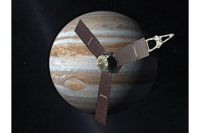Aerospace manufacturers and researchers worldwide face several ongoing challenges. One is moving older satellites to their graveyard orbit to minimize space debris and ensure they don’t collide with operational spacecraft.
A related challenge is improving electric propulsion for satellites. Interest in this technology continues to grow in popularity because it uses green propellants rather than chemical thrusters or rockets.
Some researchers, such as those at the Australian National University’s (ANU) Space Plasma, Power and Propulsion laboratory, have been focused on the technology for a long time. Since 1998, they have been developing the Helicon Double Layer Thruster (HDLT) gas plasma space engine for use on satellites.
The HDLT features a cavity that contains a metal coil and a closed end into which a gas is injected. Argon gas is commonly used, but the device also works with a Hydrazine stimulant composed of ammonia and nitrous oxide (N2O).
During engine operation, the coil generates a radio frequency field that heats up the gas so it becomes an ionized ball of plasma within the cavity. The plasma is then emitted through the open end of the cavity into space, where it expands and creates an electric field that accelerates the ions up to about 10 kilometers per second to provide the thrust.
“It’s essentially a rocket that provides thrust to move satellites around,” says Rod Boswell, a professor in the Space Plasma, Power and Propulsion laboratory at ANU. “The innovative part is that it can use almost any propellant. If you could obtain enough solar power to run the radio frequency system, you could just keep using this forever, so long as you have a propellant.”
Although the engine does not provide a large-enough thrust to propel a rocket away from earth and into orbit, it does provide sufficient thrust, once in space, to propel most satellites. This is because the HDLT can be scaled up or down as needed.
The most important component of the HDLT is the cavity, which must be made of a high-quality material to withstand the heat that creates the plasma. The researchers tried a variety of materials, including Pyrex, before considering ceramic.
When the researchers had trouble sourcing material from Australian ceramics manufacturers they contacted Morgan Advanced Materials & Technology in Greenville, SC. Morgan specializes in manufacturing alumina ceramic components and metallized assemblies used in aircraft landing gears, doors, flight control surfaces, thrust reversers and actuators.
Zachary Waddle, an engineering manager at Morgan Advance Materials & Technology, suggested the use of AL300 alumina for the cavity because of its excellent electrical properties. Shortly thereafter, Morgan developed an in-house process to make the cavity parts and built several cavity prototypes to be used in space-qualification testing.
ANU researchers are impressed with how quickly Morgan created the prototypes. They also say the prototypes are extremely sturdy and well within the required tolerances.
“Greener space applications are being seriously considered by [aerospace] manufacturers,” says Boswell. “It’s similar to how designers are continually looking to develop better electric engines for cars.”
For more information on alumina ceramic materials, call 800-999-6322 or visit www.morganamt.com.



